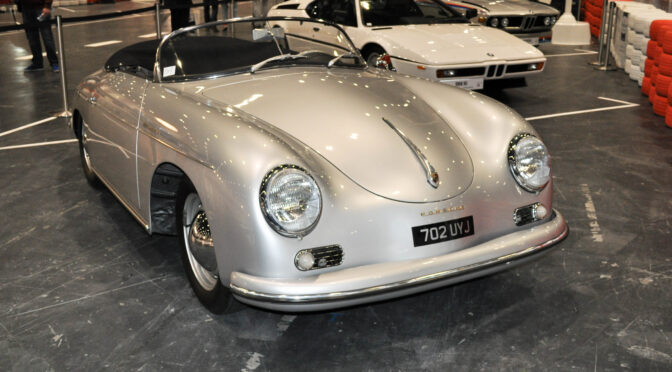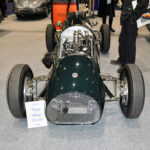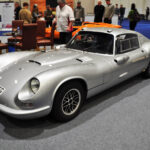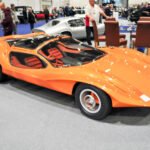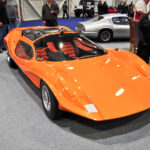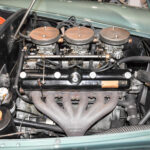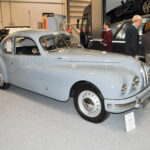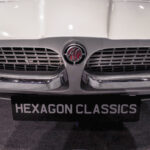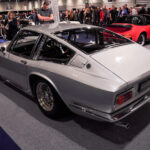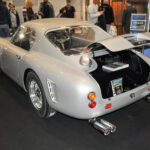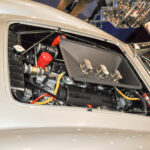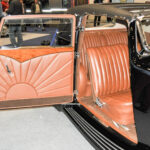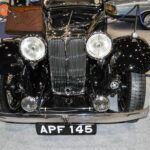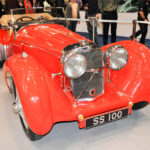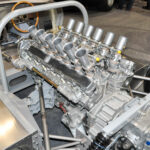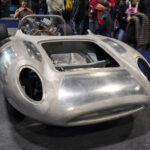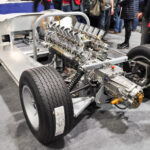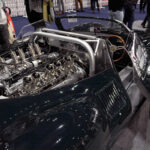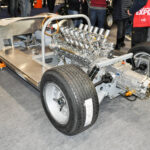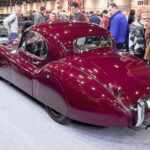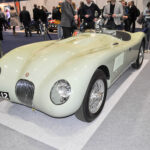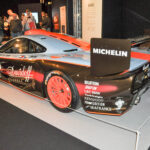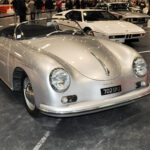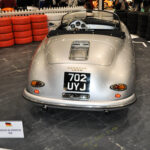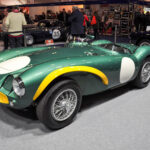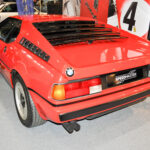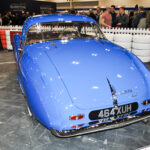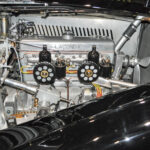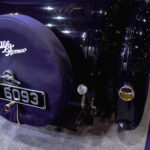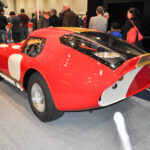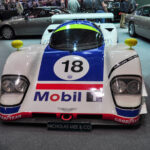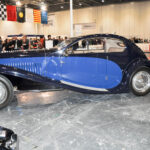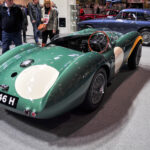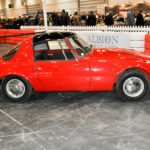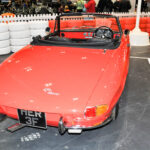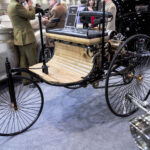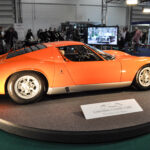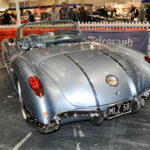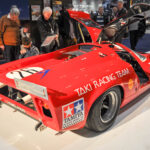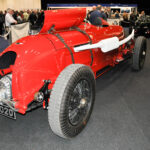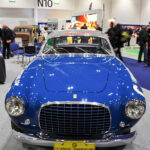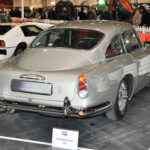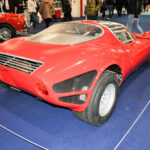This year’s London Classic Car Show at the Excel Exhibition Centre in London’s Docklands promised to be bigger and better than last year and thankfully – it was!
Spread over two large halls the show was easier to move around, it offered a more balanced mix of dealers, specialists and car club stands and last but not least it allowed for a much bigger open space in which to parade cars representing the great automotive nations.
The hall housing the majority of the club stands was first on my list to visit before it got too crowded. Visitors were treated to a fabulous turn out of club displays including BMW, Bristol, Jensen, Gordon Keeble, Mercedes, MG and others.
One stand featured some interesting specialist GRP sports cars some of which I recently featured in my British Plastic posts. The Frank Costin designed Costin Amigo for instance is a very rare car but not quite so rare as the Adams Brothers designed Probe 16 as featured in the Stanley Kubrick film A Clockwork Orange. These shared the stand with a couple of Marcos cars from each end of the manufacturing spectrum as all of these cars – Marcos, Costin and Probe were the product of a set of designers who all worked at Marcos at one time or another.
The main hall housing the Grand Avenue parade area was the next attraction. Regular parades of cars representing the various car manufacturing nations were held throughout the day giving visitors the chance to see (and hear) the cars in motion. For obvious reasons this was with the odd exception a fairly stately affair with cars inaudibly purring up and down the Grand Avenue.
The odd exceptions were some of the untameable race and rally cars which must have given the organisers kittens as they indulged in the odd throttle blip to sweep them round the potted plants marking each end of the Grand Avenue.
The driver of the wild and raucous Audi Sport Quattro S1 E2 rally car (an ex Pikes Peak winner in the hands of Walter Rohrl) seemed to have a particularly challenging time keeping revs below ear-drum-bursting level resulting in some rather spectacular belches of flame from the exhaust. Health & Safety? Who cares!
AC 428 Frua
This beautiful AC 428 caught my eye amongst a number of great cars on the Hexagon Classics stand. It’s beautiful Italian styling by Pietro Frua from the automotive powerhouse of Turin belies the fact that it is built upon a stretched AC Cobra 427 chassis.
Only 81 of these stylish and powerful cars were built between 1965 and 1973 and whilst they compared favourably with contemporary GT competition in terms of handling, bhp and mpg – they were much more expensive.
The high price of the cars was in large part down to the costly build process they went through with extended Cobra chassis being despatched to Frua in Turin to have bodywork fitted and then returned to AC’s Thames Ditton factory for the engine, transmission and trim to be added.
The 428 bears a more than passing resemblance to the Maserati Mistral Coupe (another Pietro Frua design) and the two cars even shared a small number of parts. The wholly Italian built Mistral sold in greater numbers and was the last production Maserati to use their straight six, twin spark, twin cam engine.
Coming back to the 428 – its big 7 Litre Ford FE V8 churned out 345 bhp which propelled the car to a maximum speed of 141 mph and a 0 to 62 time of 6.2 second whilst still returning around 16 mpg – not bad for such an enormous lump.
It’s a real shame that such a stylish British car was not more successful but at a price more expensive than the Aston Martin DB6 and twice the price of a 4.2 L E-Type Jag it was too exclusive for its own good.
Bizzarrini
I’m a big fan of Giotto BIzzarrini – a brilliant and much under-appreciated engineer. In my ignorance – I discovered him quite late and from research I then started to appreciate the scope and extent of his influence.
At Ferrari – he was responsible for the Testa Rossa, the 250 GT and the awe inspiring 250 GTO. After his major fall-out with Enzo he left to join ATS and he also mischievously modified Count Volpi’s Ferrari 250 GT SWB to poke fun at Enzo Ferrari with the “Breadvan” to out-perform the GTO.
After completing a commission from Ferruccio Lamborghini to produce a V12 engine – which was used in models from the 1963 350 GT to the modern Mucilage – Bizzarrini then helped Renzo Rivolta establish his sporting GT and sports cars line in the form of the Iso Rivolta and the Iso Grifo .
In continued pursuit of his racing dreams – Bizzarrinni eventually went his own way to create his eponymous company dedicated to building Bizzarrinni Strada and Corsa cars. The race cars never really achieved their full potential at the time but many are now proving to be highly successful in classic racing events.
I just love Bizzarrini’s single mindedness of design which followed a simple mantra throughout his career:-
- Lower the centre of gravity and lower the bonnet line by dry-sumping the engine and lowering the overall bodywork and chassis as much as possible
- Improve the weight balance by placing the ostensibly front engine as far back in the chassis as possible (almost making it a front/mid-engined car)
- Utilise a tried, tested and tuneable mass produced engine (in this case a 5.3 Litre Corvette V8) . This was despite Bizzarrin having previously designed the iconic Lamborghini V12 engine.
All of the cars created by Bizzarrini deserve merit but it’s nice to particularly honour those wearing the man’s name.
Ferrari 250 GT
As a Porsche owner I really shouldn’t be owing up to liking a model from arch-rivals Ferrari but I’ll risk being drummed out of the Porsche Owners Club by stating the Ferrari 250 GT is a spectacularly beautiful car.
Coincidentally it also owes it’s creation to Giotto Bizzarrini who later-on in his Ferrari tenure went on to radically modify a 250 GT to create the all conquering 250 GTO.
The GTO marked the first full-on deployment of Bizzarrini’s trade-mark modifications to lower, better balance and streamline cars for racing. In doing so – it moved sports car design away from the curvaceous bodywork of the 1950’s early ’60s towards the Kamm-tailed, be-spoilered and air-ducted beasts of the late ’60s and ’70s.
The 250GT was the last in the line of the truly pretty Ferrari GT road and race cars as form inexorably had to complement function.
Jaguar
I was amazed by the plethora of Jags of all ages, shapes and sizes, There were loads of E-types a good smattering of XKs, a few MKI and MKII saloon cars and a handful of gorgeous pre-war and pre-Jag SS (Swallow Sidecars) models.
Eagle Cars also had a big stand displaying meticulously restored E-Types as well as their modern takes on the E-Type with the Eagle Speedster and their stunning take on Jaguar’s lightweight/low drag E-Types with the Eagle Low Drag GT.
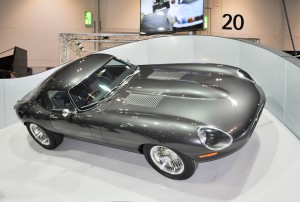
SS Jag
William Lyons really went to town in creating stylish SS sporting saloon and drop head cars. In period they must have really stood out against the rather staid 1930’s models and offered a great “Buy British” option for discerning motorists who might otherwise have had to pay much more to own Alfa Romeo or Mercedes products.
Jag XJ13
I could ramble on for ages about replicas, recreations and re-imaginings of rare cars but in essence – there are varying reasons why people make replicas:-
- Lots of Porsche 911 models are updated or backdated to create 2.7 RS replicas because the originals are rare and expensive but they can reasonably faithfully be reproduced by adapting earlier, contemporary or even later 911s.
- There are an abundance of AC Cobra replicas for the same rarity and value reason but these tend to use completely new chassis and more often than not GRP body plus all manner of donor engines.
- Some cars are recreated because the originals are so rare or fragile or because they no longer exist. The Crosthwaite & Gardiner Auto Union cars commissioned by the Audi Museum are a case in point.
There is one very simple reason why people want to recreate the XJ13 – only one car was ever made, Jaguar own it and they don’t want to sell it!
This XJ13 replica was fascinating both in finished and partly built form. It was a car or at least an engine that Jaguar wanted to build as far back as 1950 but the DOHC V12 engine was only fired-up in anger in 1964 and it was only successfully run in its wonderfully streamlined Malcolm Sayer designed body in 1966.
Despite successful testing by top race drivers Michael Hobbs and Richard Attwood the XJ13 ended up being a glorious failure as other manufacturers such as Ford with their GT40 leap-frogged it in terms of development and outright potential.
Jaguar under BMC ownership did not have the appetite to invest in potentially futile development of this beautiful looking sports car and the final ignominy came when it was wheeled out in 1971 to capture some fast driving promotional film sequences for the launch of the V12 E-Type. The car suffered a horrendous crash with Norman Dewis (Jaguar’s Chief Test Driver) at the wheel. Dewis survived but the car was completely wrecked.
Abbey Panels later rebuilt the wreck to a similar but not identical specification and this car now resides in the Heritage Motor Museum in Gaydon from where it is occasionally allowed out for demonstration runs at various circuits.
As no original XJ13 can be had for love nor money – I fully support the creation of replicas of this lovely car. The fully built up version uses the last original quad cam V12 built for Jaguar’s prototype project. Perhaps even more interestingly the recreated car wrapped around it is an attempt to get back to the original specification as laid out by Malcolm Sayer rather than copy the modified surviving XJ13. See more about Building The Legend.
Trying to recreate an accurate replica from one component part when there is no fully original car to act as a point of reference is no mean feat a bit like asking someone to replicate your favourite shirt from a surviving button!
If Jaguar had taken the plunge earlier to initially create and then onward develop this car – sports car racing history could have been very different.
Jag XK
Age or I prefer to think – maturity has shifted my Jaguar preferences from the E-Type, gangster-getaway MkI/MkII, chunky XK150, quaint split-screen XK140 to what I regard as the origin of the Jaguar sporting breed – the XK120.
I really can’t make my mind up whether the XK120 OTS or the Coupe is the most beautiful but there’s no doubting that the XK120 C-Type racing variant is sublime with it’s simple but purposeful lines and advanced engineering. This assured racing success for Jaguar in the 1950s at Le Mans with such racing legends and larger than life characters Tony Rolt and Duncan Hamilton.
I’ve just been reading Duncan Hamilton’s hilarious autobiography Touch Wood and it’s hard to believe these racing drivers were hurtling around race tracks at such crazy speeds after taking on refreshments such as champagne and cognac between driver changes! Bernie Ecclestone is always looking for ways of making F1 more exciting but obligatory cocktails for the drivers during refuelling stops probably would be taking things a step too far!
The curves of the XK120 road cars with their vestigial bumpers are redolent of the pre-war Art-deco style of coach builders such as Saoutchik and Figoni et Falaschi but with a modern twist thanks to solid engineering and especially the beautiful and potent twin cam XK engine under the curvaceous bonnet.
William Lyons had a real eye for style but his key skill was in being able to deliver style and performance in packages which were cheaper but no less desirable than the UK and continental competition.
McLaren
Since the inception of the company by the late great Bruce McLaren – the company has always strived to create the epitome of automotive perfection be it on the race track or latterly on the road and race track.
Gordon Murray – the South African born engineer persuaded McLaren’s Ron Dennis to let him build the finest supercar ever made and with the F1 its fair to say he surpassed his aim. Not only was the the road car justifiably lauded as the world’s finest supercar but race versions managed to win the Le Mans 24 hour race in 1995 the first time out.
Murray was honoured at this years Classic Car Show by a special exhibition of his road and race F1 creations – the latter including GTR and GT Longtail versions. With only 106 cars built – the F1 is a rare and coveted car which utilised an amazing number of design features including full carbon fibre monocoque, central driving position, gold foil heat shields, highly tuned BMW V12 engine and a reputation for incredible strength and reliability.
Porsche
There were quite a number of Porsche cars on show of various ages and types from 356 through 912, 911 and the beautiful Carrera 6 pictured below and beyond to the very current 918 Spyder Hybrid.
As an early 911 owner – I obviously love this period of Porsche design but I still yearn for a 356 as these cars were the very first Porsche badged cars that came into being after WWII.
What I love about the 356 is that there is not a straight line on the car. The bodywork is all swoops and curves and bar the doors, engine lid and boot lid – there’s not a bolted-on panel in sight.
Whilst I know this hand-built, welded approach was an expensive and self-indulgent attitude to car manufacture – it created some of the most beautiful but wonderfully usable and practical sports cars of the era. It is this obsession with quality which forged the Porsche brand.
Early race successes by privateer and factory teams and individual enthusiast owners fuelled rapid development of the 356 and then a number of race car variants. The Fuhrmann 4-cam engine was successfully used both in the 356 Carrera road cars and in the 550 Spyder and even the 904.
The 911 that followed was to my mind also beautiful but in a more practical and purposeful way. It’s higher volume production an ready acceptance by motoring enthusiasts both sides of the Atlantic further accelerated road and race car development leading to Porsche’s recently revived dominance in Sports Car Racing. No other manufacture can boast 17 outright wins at Le Mans.
Summary & Best Of The Rest
With precious few other motoring distractions in the midst of the winter gloom – the London Classic Car Show was well worth a visit to lift one’s spirits and get those motoring juices flowing. The number and variety of cars on show was much greater than last year – so much so that it was easy to miss little gems along the way.
Here are some of those gems:-
